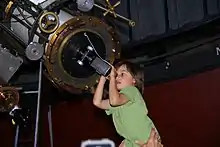STEAM fields
STEAM fields are the areas of science, technology, engineering, the (liberal) arts,[1] and mathematics. Variations of definitions for the "A" exist, but no other definition formally defines the arts with research or links the disciplines together as a whole with research. STEAM is designed to integrate all subjects with each other for a way to teach across the disciplines. These programs aim to teach students innovation, to think critically and use engineering or technology in imaginative designs or creative approaches to real-world problems framed in social studies. STEAM programs add art to STEM curriculum by drawing on reasoning, ethics and design principles and encouraging creative solutions, effectively removing the meaning of the STEM distinction as the term now includes nearly all academic fields.[2][3][4][5]
National STEAM Day
National STEM/STEAM Day is celebrated on November 8 and is intended to be a play on the word innovate (Nov 8).[6]

STEAM Day was established and made an official holiday by MGA Entertainment in 2015. "We want to show children that S.T.E.M. and S.T.E.A.M. are already all around them, and that their favorite hobbies are actually rooted in science, technology, engineering, art and math," said Isaac Larian, CEO of MGA Entertainment.[7]
STEAM in children's media
- Sesame Street's 43rd season continues to focus on STEM but finds ways to integrate art. They state: "This helps make learning STEM concepts relevant and enticing to young children by highlighting how artists use STEM knowledge to enhance their art or solve problems. It also provides context for the importance of STEM knowledge in careers in the arts (e.g. musician, painter, sculptor and dancer)."[8]
- MGA Entertainment created a S.T.E.A.M. based franchise Project Mc2.[7]
Other uses of the STEAM acronym
- Other variations that have been promoted, include art, fine arts, agriculture, architecture and applied mathematics.[9][10]
- The Rhode Island School of Design has a STEM to STEAM program and maintains an interactive map that shows global STEAM initiatives. Relevant organizations are able to add themselves to the map. John Maeda, (2008 to 2013 president of Rhode Island School of Design) has been a champion in bringing the initiative to the political forums of educational policy.
- Some programs offer STEAM from a base focus like mathematics and science.[2]
- SteamHead is a non-profit organization that promotes innovation and accessibility in education, focusing on STEAM fields.
- Wolf Trap's Institute of Education, as part of a $1.5 million Department of Education grant, trains and places teaching artists into preschool and kindergarten classrooms. The artists collaborate with the teachers to integrate math and science into the arts.[11]
- American Lisa La Bonte, CEO of the Arab Youth Venture Foundation based in the United Arab Emirates, uses the STEAM acronym, but her work does not include arts integration.[12] Starting in 2007, La Bonte created and ran high profile free public STEAM programs [13] having added an A for "inspired STEM", with the A standing for Aeronautics, Aviation, Astronomy, Aerospace, Ad Astra! and using all things "air and space" as a hook for youth to embark on greater experimentation, studies, and careers in the region's burgeoning space related industries.[14] One of AYVF's best-known programs,[12] "STEAM@TheMall", served over 200,000 its first two years at the most popular shopping malls[12] and provided free weekend activity stations such as Mars robotics, science experiments, SkyLab portable planetarium, art/design, and creative writing.[12] In 2008, Sharjah Sheikha Maisa kicked off the "Design booth for youth for Al Ain Summer S.T.E.A.M. funded by the Foundation created by the Crown Prince of Abu Dhabi".[15] In 2010, the American Association of Arts & Sciences (AAAS) included a chapter on AYVF's most popular STEAM program in its book, Building Mathematical and Scientific Talent in the Broader Middle East and North Africa (BMENA) Region.[16]
See also
References
- "STEAM Rising: Why we need to put the arts into STEM education". Slate. Retrieved 2016-11-10.
- Jolly, Anne (18 November 2014). "STEM vs. STEAM: Do the Arts Belong?". Teacher. Education Week: Teacher. Retrieved 6 September 2016.
- Pomeroy, Steven Ross. "From STEM to STEAM: Science and Art Go Hand-in-Hand". blogs.scientificamerican.com. Scientific American. Retrieved 17 November 2016.
- Eger, John (31 May 2011). "National Science Foundation Slowly Turning STEM to STEAM". www.huffingtonpost.com. Huffington Post. Retrieved 17 November 2016.
- "STEAM learning matters. Science, Technology, Engineering, and Mathematics". www.cbs8.com. CBS News. Retrieved 17 November 2016.
- Schonberg, Angela (8 November 2017). "National S.T.E.M./S.T.E.A.M. Day". Huff Post. Retrieved 30 October 2019.
- Entertainment, M. G. A. "November 8 Is National S.T.E.M./S.T.E.A.M. Day". www.prnewswire.com. Retrieved 2019-11-06.
- Jean-Louis, Rosemary (24 August 2012). "Sesame Street: New Season Focuses on S.T.E.A.M." gpb.org. Retrieved 30 October 2019.
- "Virginia Tech and Virginia STEAM Academy form strategic partnership to meet critical education needs". Virginia Tech News. 31 July 2012.
- "Public Engagement | Academics | RISD".
- Chen, Kelly; Cheers, Imani (31 July 2012). "STEAM Ahead: Merging Arts and Science Education". PBS News Hour. PBS. Retrieved 7 March 2015.
- Bonte, Lisa. "AYVF - Strategic Space & STEM Workforce Pioneer". AYVF - Strategic Space & STEM Workforce Pioneer. Retrieved 28 October 2019.
- "Weekend Getaways!".
- "STEAM Franchises". AYVF - Strategic Space & STEM Workforce Pioneer. April 17, 2013. Retrieved 28 October 2019.
- "AYVF awarded prestigious Grant from Emirates Foundation".
- https://www.aaas.org/sites/default/files/BTC_LaBonte_E.pdf
